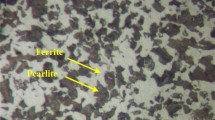Abstract
This paper presented a finite element simulation model for the analysis of AISI D2 steel turning with TiAlN-coated inserts. In this study, material constitutive model of hardened AISI D2 steel (HRC62) was built based on power law relationship, which was used in the FEM codes to describe the effect of strain, strain rate, and temperature on the material flow stress. A damage model was employed to predict the chip separation. Cutting edge radius and thickness of TiAlN coating were obtained by micro-optical system and SEM, respectively. The average friction coefficients were obtained by ball-on-disk friction test using UMT-2 high-speed tribometer. Numerical simulations of AISI D2 steel turning were performed using AdvantEdge™ software. The simulated results of forces and chip morphology showed good agreement with the experimental results, which validated the precision of the process simulation method. The shear stress on the interface between coating and substrate of cutting tool was analyzed. And the maximal shear stress between coating and substrate was found on the cutting edge roundness near the flank face of cutting tool.
Similar content being viewed by others
References
Grzesik W, Bartoszuk M, Nieslony P (2005) Finite element modelling of temperature distribution in the cutting zone in turning processes with differently coated tools. J Mater Process Technol 164–165:1204–1211
Grzesik W, Bartoszuk M, Nieslony P (2004) Finite difference analysis of the thermal behaviour of coated tools in orthogonal cutting of steels. Int J Mach Tools Manuf 44:1451–1462
Brito RF, Carvalho SR, Silva SMML et al (2009) Thermal analysis in coated cutting tools. Int Commun Heat Mass 36:314–321
Kone F, Czarnota C, Haddag B et al (2011) Finite element modelling of the thermo-mechanical behavior of coatings under extreme contact loading in dry machining. Surf Coat Tech 205:3559–3566
Qin F, Chou YK, Nolen D et al (2009) Coating thickness effects on diamond coated cutting tools. Surf Coat Tech 204:1056–1060
Bouzakis KD, Michailidis N, Hadjiyiannis S et al (2001) Improvement of PVD coated inserts cutting performance, through appropriate mechanical treatments of substrate and coating surface. Surf Coat Tech 146–147:443–450
Bouzakis KD, Hadjiyiannis S, Skordaris G et al (2004) The effect of coating thickness, mechanical strength and hardness properties on the milling performance of PVD coated cemented carbides inserts. Surf Coat Tech 177–178:657–664
Özel T (2006) The influence of friction models on finite element simulations of machining. Int J Mach Tools Manuf 46:518–530
Bil H, Kilic SE, Tekkaya AE (2004) A comparison of orthogonal cutting data from experiments with three different finite element models. Int J Mach Tools Manuf 44:933–944
Jiang F, Li JF, Rong YM et al (2008) Study of cutting temperature in cold-air milling of Ti6Al4V alloy. In: Mamoru M, Kanji U, Fumihiko K (eds) 41st CIRP conference on manufacturing system. Tokyo, Japan, pp 371–376
Movahhedy MR, Gadala MS, Altintas Y (2000) FE modeling of chip formation in orthogonal metal cutting process: an ALE approach. Mach Sci Technol 4:15–47
Movahhedy MR, Altintas Y, Gadala MS (2002) Numerical analysis of metal cutting with chamfered and blunt tools. J Manuf Sci E-T ASME 124:178–188
Adibi-Sedeh AH, Madhavan V (2003) Understanding of finite element analysis results under the framework of Oxley’s machining model. 6th CIRP International Workshop on Modeling of Machining Operations. McMaster University, Hamilton
Becze CE (2001) A thermo-mechanical force model for machining hardened steel. Ph.D. thesis, McMaster University
Jiang F, Li JF, Sun J et al (2010) Al7050-T7451 turning simulation based on the modified power-law material model. Int J Adv Manuf Technol 48:871–880
Author information
Authors and Affiliations
Corresponding author
Rights and permissions
About this article
Cite this article
Jiang, F., Yan, L. & Rong, Y. Orthogonal cutting of hardened AISI D2 steel with TiAlN-coated inserts—simulations and experiments. Int J Adv Manuf Technol 64, 1555–1563 (2013). https://doi.org/10.1007/s00170-012-4122-3
Received:
Accepted:
Published:
Issue Date:
DOI: https://doi.org/10.1007/s00170-012-4122-3




